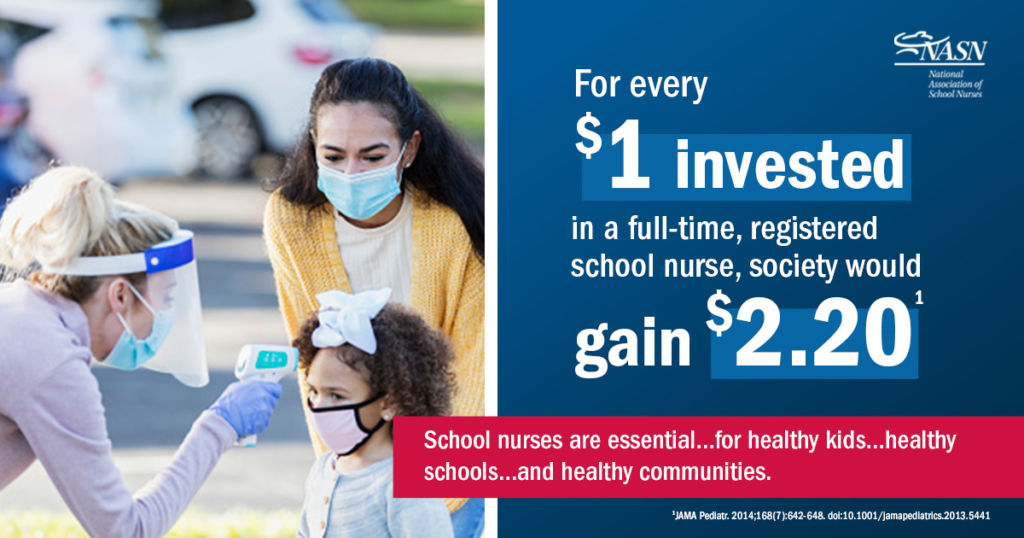Does your school have a full-time professional registered school nurse? Did you know that across the US, 25% of our nation’s school children do not have access to a school nurse and 35% have only a part-time school nurse.
School Nursing has been described as the hidden health care system in our schools. The presence of school nurses in our schools level the playing field for our students, and school nurses serve to deliver health care to our most vulnerable and underserved students. In some rural areas in Indiana, the school nurse is the primary health care provider for the majority of the students. In most schools we also serve staff, and by extension, our communities. Our recent pandemic experience with COVID brought to light what has been a best kept secret in our schools for too long….that school nurses bridge the gap between health and learning. “We cannot educate children who are not healthy, and we can’t keep them healthy if they’re not educated.”- Dr Jocelyn Elders, former Surgeon General.
“We cannot educate children who are not healthy, and we can’t keep them healthy if they’re not educated.” Dr Jocelyn Elders, former Surgeon General
Ever wonder how school nursing began? It began as an experiment in 1897 when the New York City Board of Health hoping to correct high absenteeism instituted a medical inspection program with 150 physicians who were hired for an hour per day to inspect for infectious disease and exclude from school those students found to be infectious. Unfortunately, many parents of that day couldn’t read the written treatment instructions or afford treatment, and their children stayed home and played with the neighborhood children. After this initial failure, it was decided to collaborate with an experienced public health nurse, Lillian Wald, to work at 4 schools and provide home visits and parent training. Data collection proved the success of this venture when it was revealed 10,567 students were absent in October 1902 and with the nurse intervention there were only 1,101 absent in September of 1903 – a 90% decrease in absenteeism. Due to this success, the specialty of school nursing was born!
What a difference a century makes, or does it? In the early 1900s these early pioneering school nurses were fighting the spread of disease, battling absenteeism, combating the social determinants of health (today’s health equity), educating families and collecting data to prove their worth. The school nurse of today continues these duties and is also addressing chronic health concerns that once prevented school attendance, bridging the gap for access to health care and confronting students’ mental health needs and addiction struggles. It has been shown that for every dollar spent on a professional registered school nurse society benefits $2.20 (source*).

Indiana code in the Student Services rule addresses School Nurse staffing by recommending a ratio of one RN to 750 students and additionally only requires one Bachelor’s of Science in Nursing prepared Registered Nurse for each School District to act as the Coordinator for the District. There is no enforcement of this code. Current data for Indiana specifically has historically been very hard to determine. The most recent data survey by IN DOE was completed in 2018, response was voluntary and was sent to all school superintendents. The responses were thought to represent about 54% of Indiana’s school children being served by a full time professional registered school nurse (data sheet). This recent survey estimated that Indiana’s ratio is closer to 1 to 918 (source).
The National Association of School Nurses (NASN) defines school nursing as a specialized practice of nursing that protects and promotes student health, facilitates optimal development, and advances academic success. School nurses, grounded in ethical and evidence-based practice, are the leaders who bridge health care and education, provide care coordination, advocate for quality student-centered care, and collaborate to design systems that allow individuals and communities to develop their full potential. The NASN vision is that students are healthy, safe, and ready to learn.
“School nurses, grounded in ethical and evidence-based practice, are the leaders who bridge health care and education, provide care coordination, advocate for quality student-centered care, and collaborate to design systems that allow individuals and communities to develop their full potential.”
School nurses must work within the confines of the Indiana Nurse Practice Act and also function within the 21st Century School Nurse Framework. The basic tenets of this framework are Care Coordination, Leadership, Community/Public Health, Standards of Practice and Quality Improvement. The overriding component of School Nursing Practice has placed the students, faculty, and community at their center of focus (learn more*).
As summer winds down and parents and students are getting ready to return to the classroom, your school nurse is hard at work preparing to greet students as well. He/she will be busy obtaining needed licensed health care provider orders, stocking the cabinets and supplies, meeting with parents of students with chronic and special health needs, and developing individual health plans as needed for those students to optimize their classroom success. Most school nurses are also checking on required immunizations for each of their students, reviewing health information for all students and training staff as needed who are designated in student’s health plans to carry out daily care when appropriate. Many are also involved in required staff and faculty training sessions for bloodborne pathogens and emergency treatments and plans for students with asthma, diabetes, severe allergies, and seizures. There also needs to be preparation and planning for vision and hearing screening at the required student grade levels and follow-up as needed to make sure that families have the resources they need to obtain vision and hearing care services when needed as revealed through screening. Many school nurses prepare first aid bags for staff (gloves and Band-Aids) and provide training on basic first aid and “when to send your student to the School Nurse.” Most school nurses also provide emotional first aid to many of our students struggling to learn and dealing with trauma and ACES in their home. They often make referrals for follow-up by school counselors or social workers for potentially more intervention as needed. That “stomach-ache” or “headache” that shows up every morning or afternoon in the school nurse office is often a cry for help and a sign that more is going on behind the scenes and needs investigation.
Keep in mind the School Nurse can benefit your school in 5 important ways:
Attendance
Schools with a full-time school nurse have about ½ the average early release from school due to illness or injury.
Academics
School Nurses work to keep students at school healthier and better able to participate and potentially reducing drop-out rates.
Time
School Nurses save time for principals, teachers, and staff by addressing health related issues, as much as an hour a day for principals, 20 minutes a day for educators and 45 minutes a day for clerical staff.
Staff Wellness
School Nurses have been shown to improve the overall health of staff.
Accountability
Monitoring compliance with Federal and State laws can mitigate lawsuits.
(source)
Yes, your school nurse is busy, often behind the scenes, working to keep kids in school healthy, safe, and ready to learn. So, the next time you walk by the School Nurse office stop in and introduce yourself and explore ways together that you can optimize the health of the students in your classroom to have their healthiest and most successful school year so far!
 * Reprinted with permission by the National Association of School Nurses
* Reprinted with permission by the National Association of School Nurses
Resources
Please login or register to claim PGPs.
Alternatively, you may use the PGP Request Form if you prefer to not register an account.



